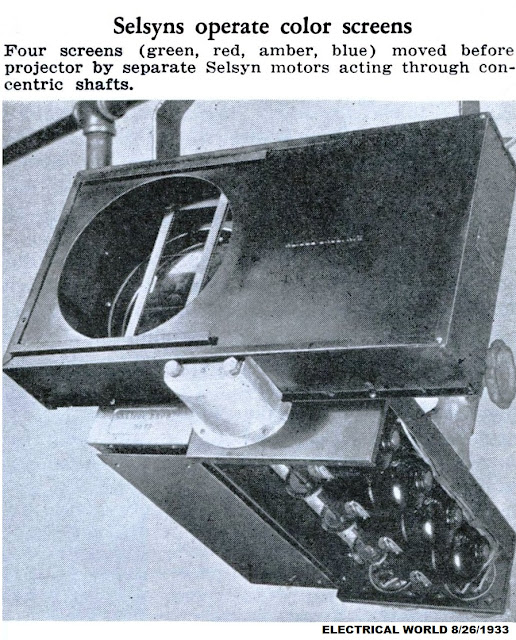The New York Center Theatre (1932-1954) was the sister theatre to Radio City Music Hall and according to Cinema Treasures seated 3510, compared to the Music Hall's 5940, placing both theatres in the "super deluxe movie palace" category. (For a complete description of Radio City Music Hall electrics, click here.
The Center (circled) was located on Sixth Avenue between 48th and 49th streets, the Music Hall between 50th and 51st.
Looking west on 49th Street.
The new Roxy made the old Roxy (1927) look terribly old-fashioned. Until Radio City was built, the 5886-seat Roxy was the largest theatre in the world.
Both Radio City Music Hall and the Center were "under the personal direction of Roxy" (Samuel Rothafel) who had been hired away from the true Roxy Theatre by RKO, a new Hollywood studio and subsidiary of RCA, who leased the new theatres from the Rockefellers.

The Peter Clark equipped stage of the Center was a scaled down version of the Music Hall, with a proscenium opening sixty feet wide, with a seventy-foot high nine-motor contour curtain which concealed the forty foot arch.
The bandwagon probably lived on the orchestra pit elevator, since according to the drawings herein, there was no basement storage garage. This solution covered the lift for the Wurlitzer organ console, likely prompting a post-construction alternative.
The Super deluxe movie places were designed in anticipation of the invention of projection devices which could fill much larger picture sheets than the one shown below.
A PDF on the selsyn patent may be seen by clicking here.
There were ten front lights, larger DC arc versions of the 2K plano-convex stage spotlights, without reflectors.
The houselights were newly-designed ellipsoidal downlights, credited to Stanley McCandless.
Eighteen months later, Kleigl introduced the ellipsoidal reflector spotlight as "the new Klieglight." "Leko" was the trade name for Century's equivalent fixture, which debuted soon thereafter.
The drawings below, as well as selected HD photos, can be seen and downloaded in PDF format by clicking here.
Drawings of a remarkably similar stage were included in the 1950's catalog for Joseph Vasconcellos, "successor to Peter Clark." The Center had no revolving organ lift, however.
Originally the Music Hall had been intended as a music hall and the Center as a presentation house, playing RKO pictures and a stage show, changing weekly. However, Roxy's opener at the Music Hall was a failure of such catastrophic proportions that the Center's presentation policy was quickly transferred to the Music Hall, leaving the Center in danger of folding. RKO, like the other major studios, produced only one picture a week, so having two adjacent New York flagships was excessive, to say the least.
Under legal pressure from the actual Roxy Theatre and with no fanfare whatsoever, the RKO Roxy became the "RKO Center" a year after it had opened.
The matching marquees of the Music Hall (left) and the Center can be seen in this photo,taken after the Sixth Avenue El was eliminated.
In 1934 the Center turned legit and became the largest B'way house, presenting spectacular versions of musical book shows, the first of which was a revival of "The Great Waltz."
By 1940 they had turned to ice, which sustained them for a decade. Below, "Howdy Mister Ice of 1950."
In 1950, NBC leased the Center, converting it to a television theatre. All broadcasts were live.
Both Rockefeller Center lighting switchboards were prototypes of the newly-developed electronic type. Unlike resistance boards then in use, electronic boards allowed for pre-setting of dimmers; proportional mastering; and the vast number of gridloft and auditorium circuits could home-run to remote dimmer banks located in the attic, instead of to the stage board. The GE (General Electric) thyratron-reactor board at the Radio City Music Hall was widely publicized, in particular its location in the auditorium. To learn everything about the Music Hall switchboard, click here.
The original Hub board at the Center Theatre was not publicized; in fact no photographs and only one mention have thus far been discovered.
Apparently the Hub board was a lemon, a clunker, and a failure, so bad that it was ripped out and replaced by a Westinghouse in time for the September, 1934 opening of "The Great Waltz." Like at the Music Hall, the new Center board was a five-scene preset, but it was located backstage.
The replacement board utilized the first Ward Leonard "Hysterset" dimmers and was documented in the article summarized below, which can be viewed and downloaded by clicking here.
Hysterset boards, including the Center, are featured in the 1945 Ward Leonard Bulletin 74 which can be viewed by clicking here, courtesy Rick Zimmerman.
And in 1951, a third casualty was the Master Electrician.
The final casualty was the Center itself, gutted rather than demolished in 1954, its place taken by offices.
For a master index of all photo-essays, click here.
October 2016, revised March 2020.












































